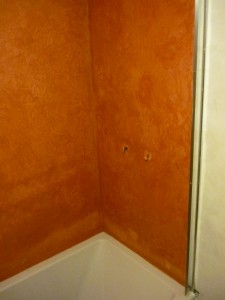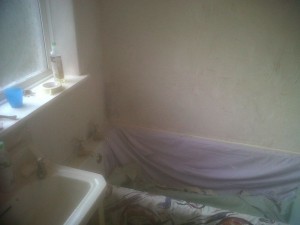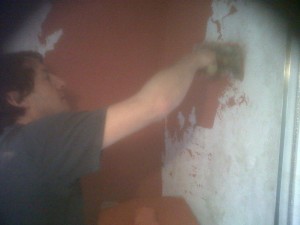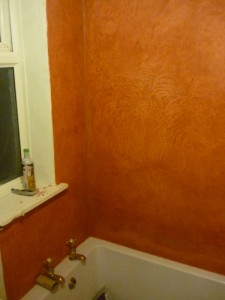16 Nov 2010
Brand New Tadelakt
 Had great fun over the weekend plastering my shower with this amazing stuff called Tadelakt. Tadelakt is a traditional Moroccan plaster, a lime-based, polished waterproof plastering technique. Originally used for waterproofing cisterns, and then used for public bathing houses, Tadelakt had almost disappeared from use before being rediscovered and there is currently a revival in its use. The real Tadelakt is produced from a specific lime found in the foothills of Marrakesh, but something almost as good can be produced from limes found here too. Clearly importing plasters half the way around the world is not the greatest use of finite fossil fuels (nice of the IEA by the way to inform us last week that the peak in conventional oil production happened in 2006 after denying the very idea for years… anyway I digress…), so it is good to know we can get by with a more locally-made version too.
Had great fun over the weekend plastering my shower with this amazing stuff called Tadelakt. Tadelakt is a traditional Moroccan plaster, a lime-based, polished waterproof plastering technique. Originally used for waterproofing cisterns, and then used for public bathing houses, Tadelakt had almost disappeared from use before being rediscovered and there is currently a revival in its use. The real Tadelakt is produced from a specific lime found in the foothills of Marrakesh, but something almost as good can be produced from limes found here too. Clearly importing plasters half the way around the world is not the greatest use of finite fossil fuels (nice of the IEA by the way to inform us last week that the peak in conventional oil production happened in 2006 after denying the very idea for years… anyway I digress…), so it is good to know we can get by with a more locally-made version too.
So, I am redoing my bathroom. When I moved into my current house, we inherited a bathroom that almost certainly wasn’t even fashionable when it was installed in the early 1970s, but certainly pale blue bath, toilet and sink and brown tiles with gold flower motifs don’t really do it for me. Anyway, that certainly isn’t sufficient excuse to toss out a functioning bathroom, so it was only when the bath sprung a leak, the toilet sprung a leak in sympathy, the sink came away from the wall, the toilet seat broke free from its moorings and the floor started to go rotten that we decided it was time for a change.
After a couple of weeks of stripping the last section of woodchip wallpaper left in the house (we have stripped acres of it since we moved in) and smashing tiles off the wall, we finally got back to the bare bones of a bathroom. Most of the room I replastered with a lime plaster (gorgeous, and bought ready-mixed, a revelation!), but around the shower we had a choice. Did we do tiles, which are a lot of work, easy to get a bit wrong so that water gets in behind them, and often not that nice, or did we perhaps do something else?
A couple of weeks ago I went round to my friends Paul and Ivana round the corner who are building the most gorgeous cob house in history, and checked out the bathroom they had just finished, and it blew me away. They had rendered the whole room with Tadelakt, and it looked and felt like the inside of a glazed pot. It was warm, curvy, beautiful, with a gorgeous lustrous shine to the whole thing. “That’s what I want” I decided… Luckily, after I had dragged my family round to see it, they agreed too.
I ordered 20kg of it from Mike Wye Associates who are suppliers of natural building stuff here in Devon. They supply Tadelakt mixed to one of 54 colours on their lime pigment chart. It comes as a powder which you mix up to the consistency of stiff icing in the tub, using a plasterer’s whisk. Paul (he of gorgeous cob house fame) kindly came round to give me a hand on Saturday, and so, with Man Utd against Aston Villa playing on the radio, we set to work. The plaster went on easily enough in two layers, the second of which we trowelled as smooth as we could with a plastic float.
When the second layer had had a day to dry, I applied a Moroccan Black Soap and rubbed the wall up with a smooth stone, which compacts the surface. It is hard work, very physical, but it is the energy you put into it that gives it the finish it is famed for.
I still need to give it a couple more layers, but already it is looking gorgeous. Much nicer than tiles. But can it really bear up to the wear and tear of being the shower for a family of six? Time will tell, but I have to say it is far more enjoyable to put in place than tiles, far more beautiful, and has a quality to it that is really very special. It already feels like stone, with a lovely irregular patterning to it. I’m hooked. No more tiles for me….



Mary
16 Nov 9:59am
Your digression provided my biggest laugh of the week. The reporting went like this:
“It was a looming doomsday scenario: “Peak oil” would someday hit, potentially sending food prices soaring, stock markets reeling, and countries to war to seize and protect remaining oil reserves.
Instead, the International Energy Agency said Tuesday, peak crude oil already came and went unnoticed in 2006.
Crisis averted, apparently.”
Well I for one was glad to know that food prices would not be soaring, that the stock markets would not be reeling, and that we were in no danger of going to war to protect…wait…um….
Cristiano Bottone
16 Nov 3:57pm
Incredible, I was studying this Tadelakt just yesterday. Please let us know more after the winter…
Johan
16 Nov 5:21pm
why after winter ?
will you start a project after winter or do you think the cold season will cause it to fail ?
Rob Hopkins (In Florida)
16 Nov 5:35pm
Thanks for that one, we just tiled my wife’s shower, which is something I intensely dislike doing. The other bath needs doing, as it was built in 1980, and is a bit shabby. I also want to look at the plumbing, I had to do a little work on the other bath. I hadn’t stumbled over the Tadelakt before, but I’ve done a goodly amount of plastering over the years. I’ll have to find it in our area. I have another rainbarrel and a cistern to put in first, our area is prone to winter droughts, and that’s our main growing season for vegetables, because it gets so hot in the summers. I had an amusing time ordering “Local Food” from your folks, they couldn’t figure out why you needed to go through them to get more copies, and ship them to America…
Cristiano Bottone
17 Nov 9:47am
@ Johan – Well… after a while to see how it reacts to humidity and use…
Winfield
17 Nov 12:21pm
Nice work. I am a building inspector and building scientist, so I recommend covering the window during shower use. Caulk can never water-proof a window. You probably discovered water damaged studs during the renovation. Sorry to be a nerd, but is the glass tempered, safety glass. You don´t want to slip and slit your wrist by putting your hand through the glass.
hugh owens
18 Nov 12:30am
Nice article and pics. I have put in many bathrooms and showers from wood to stone, tile and fiberglass. Properly done, tile is hard to beat and will never leak if done correctly with good ventilation and components. Cheap installations last 10 or 20 years. I love the looks but cleaning up mildew and soap scum with just wax protection sounds problematic. I think a satin or gloss epoxy sealer might be the ticket but it wont adhere to anything with wax. I may try it. Also, are all of us PO bloggers writing about the IEA report!!
Alex the plasterer
18 Nov 1:08pm
Couple of things came to mind regarding your application of Tadelakt. If you don’t want your tadelakt to fail and the wall is exposed to water and moisture then you need to make your substrate really waterproof – just like a shower enclosure for tiling.
Firstly you ought to really use some kind of cement based board for areas that will be exposed to water. You could also tank this just to make sure. With areas that aren’t exposed to water you can get away with moisture resistant plasterboard or if the substrate is good you can get on with the next step, which is priming. You should have really primed the substrate with lime wall finish before applying the tadelakt. Otherwise I can’t help thinking that your tadelakt will fail at some point. Which isn’t a good look.
I also noticed that you applied your wax before compressing the tadelakt with a ceramic stone. You should compress the tadelakt with a plastic trowel – a steel trowel will leave black marks, then you can compress it with a ceramic stone. You can use a little bit of wax soap to ‘bring it back’ and help lubricate the stone, but I wouldn’t wax it then compress it. That probably explains the textured circular marks in your finish above the bath.
Hope that helps and your tadelakt stays put!
btw mike wye runs courses on tadelakt and venetian polished plaster 😉
Johan
21 Nov 11:40am
what are the maintenance procedures for this tadelakt ? does it need rewaxing ? hox often ?